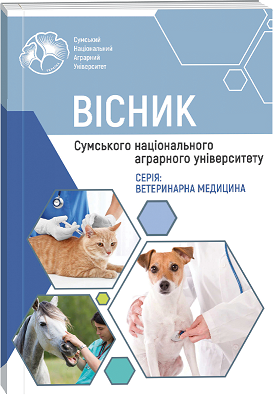PRODUCTION OF QUALITY AND SAFE COW'S MILK
Abstract
The article emphasizes that disruptions in metabolic processes within animal bodies can lead to decreased productivity and a decline in the quality of products derived from them. The research presented in the article is based on the analysis of amino acid composition and the fat-soluble vitamins A, E, and D, as well as the water-soluble vitamins B2 and C in the milk of cows affected by ketosis. This study was carried out in an accredited laboratory. The findings reveal that disturbances in the animal's diet and overall well-being, particularly in the initial days after the onset of the condition, result in a negative energy balance. This prompts the utilization of the body's own fat reserves, leading to the production of a significant quantity of ketone bodies. The liver is unable to adequately process these ketone bodies, allowing some of them to enter the bloodstream, resulting in systemic poisoning. The research indicates a significant and statistically reliable increase (p≤0.01) in the levels of vitamin A in the milk of cows, with a noticeable tendency towards an increase in vitamin E content. Meanwhile, there is a minor decrease in vitamin D content, although this difference is not statistically significant. This suggests that the body is making some effort to combat the issue independently. Notably, both vitamins A and E serve as antioxidants. However, there were no significant alterations detected in the levels of water-soluble vitamins like B and C. The obtained results indicate that under unfavorable conditions of maintenance, such as tethering and an imbalanced diet, it leads to disruptions in the animals' homeostasis, resulting in the development of diseases. The most significant changes were observed in the levels of ketone bodies, with their increase by up to 5 times (p≤0.01). Additionally, there was an increase in urea and total protein content (p≤0.01). At the same time, there was an increase in the levels of urea and total protein (p≤0.01). It is known that urea in serum is the end product of protein metabolism and is primarily synthesized in the liver, serving as an indicator of excessive protein feeding. This urea parameter informs about dietary imbalances. The examination of total blood protein showed that its quantity had doubled. Conversely, there is a 2-3 times decrease in blood glucose levels (p≤0.01), indicating an insufficient amount of carbohydrates in the diet. The reduction in blood buffering capacity suggests an imbalance between acids and alkaline substances in the cows' bodies, leading to the development of metabolic acidosis in these animals (p≤0.01). Other biochemical blood parameters remain within the normal range.
References
2. Elsaadawy, S. A., Wu, Z., & Bu, D. (2022). Feasibility of Supplying Ruminally Protected Lysine and Methionine to Periparturient Dairy Cows on the Efficiency of Subsequent Lactation. Frontiers in Veterinary Science, 9, 892709. https://doi. org/10.3389/fvets.2022.892709.
3. Kasalová E., Aufartová J., Krčmová LK, Solichová D., Solich P. (2015). Recent Trends in the Analysis of Vitamin D and Its Metabolites in Milk – Review. 2015; 171:177–190. doi: 10.1016/j.foodchem.2014.08.102.
4. Kasalová E., Aufartová J., Krčmová LK, Solichová D., Solich P. (2015). Recent Trends in the Analysis of Vitamin D and Its Metabolites in Milk – Review. Food Chemistry, 171, 177–190. doi: 10.1016/j.foodchem.2014.08.102.
5. Poulsen N.A., Rybicka I., Poulsen H.D., Larsen L.B., Andersen K.K., Larsen M.K. Seasonal variation in the content of riboflavin and major minerals in bulk milk from three Danish dairies. Int. Dairy J. 2015;42:6–11. doi: 10.1016/j. idairyj.2014.10.010.
6. Rodriguez, Z., Wynands, E., Shepley, E., Baumgard, L. H., Cramer, G., & Caixeta, L. S. (2021). Exploring the role of milk yield in the first week of lactation on the association between hyperketonemia and reproductive performance in dairy cattle. JDS Communications, 3(1), 7–12. https://doi.org/10.3168/jdsc.2021-0129
7. Scholtz-Arens K.E., Arens F., Bart K.A. (2020). (2020). Food and Medical Properties of Milk and Milk Substitutes. Eur. J. Nutr. 2020; 59: 19–34. doi: 10.1007/s00394-019-01936-3.
8. Schwab E.C., Shaver R.D. B-Vitamin Nutrition in Dairy Cows. Journal of Nutrition. 2006; 136: 1326–1336.
9. Song, Y., Wang, Z., Zhao, C., Bai, Y., Xia, C., & Xu, C. (2021). Vitamin A in cow's milk. Veterinary Research, 65(3), 361–368. doi: 10.2478/jvetres-2021-0035.
10. Walter, L. L., Gärtner, T., Gernand, E., Wehrend, A., & Donat, K. (2022). Effects of Parity and Stage of Lactation on Trend and Variability of Metabolic Markers in Dairy Cows. Animals: An Open-Access Journal from MDPI, 12(8), 1008. https:// doi.org/10.3390/ani12081008
11. Wankhade, P. R., Manimaran, A., Kumaresan, A., Jeyakumar, S., Ramesha, K. P., Sejian, V., Rajendran, D., & Varghese, M. R. (2017). Metabolic and immunological changes in transition dairy cows: A review. Veterinary World, 10(11), 1367–1377. https://doi.org/10.14202/vetworld.2017.1367-1377.
12. Yehia, S. G., Ramadan, E. S., Megahed, E. A., & Salem, N. Y. (2020). Effect of parity on metabolic and oxidative stress profiles in Holstein dairy cows. Veterinary World, 13(12), 2780–2786. https://doi.org/10.14202/vetworld.2020.2780-2786
13. Zandkarimi, F., Vanegas, J., Fern, X., Maier, C. S., & Bobe, G. (2018). Metabotypes with elevated protein and lipid catabolism and inflammation precede clinical mastitis in prepartal transition dairy cows. Journal of Dairy Science, 101(6), 5531–5548. https://doi.org/10.3168/jds.2017-13977
14. Zhao, C., Bai, Y., Fu, S., Wu, L., Xia, C., & Xu, C. (2020). Metabolic alterations in dairy cows with subclinical ketosis after treatment with carboxymethyl chitosan-loaded, reduced glutathione nanoparticles. Journal of Veterinary Internal Medicine, 34(6), 2787–2799. https://doi.org/10.1111/jvim.15894.

 ISSN
ISSN  ISSN
ISSN 



